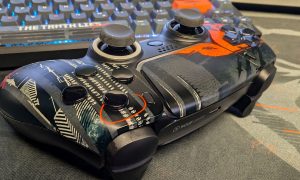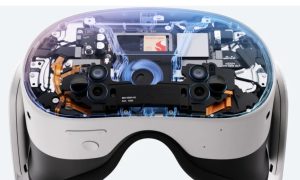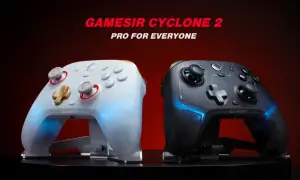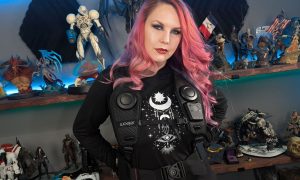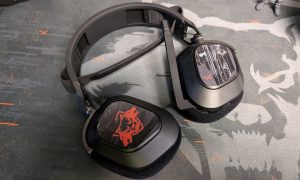The Nintendo Switch is just around the corner, releasing on March 3rd, but what can you expect when the Big N’s new flagship product ships? What do you need on day one? What games are going to be available to pick up with your shiny new system? Not to worry — Gaming Trend has you covered.
The System:
First off, you should know that the Switch is not strictly a console in the traditional sense of the word. In fact, it’s more of a hybrid between the wildly-successful 3DS hardware line and the Wii U. Sliding into a dock (more on that in a bit), the system can operate like any other console would, throwing gorgeous 1080p imagery onto your favorite TV. Unlike any other console, when you need to take your game on the road, the Switch can be slid out of the dock without missing a beat. Looking at the Wii U, this feels like what Nintendo intended for that console.
The console itself has a 6.2” 10-point multi-touch capacitive LCD screen with haptic feedback support operating at 720p resolution. Nintendo estimates that the battery will last somewhere between 6 and 3 hours, depending on the graphical demands of the game you are playing. (The Legend of Zelda: Breath of the Wild, as an example, will cut your battery to 3 hours) For a frame of reference, the New 3DSXL’s battery life is between 7 and 3.5 hours when playing 3DS games. Recharging the system is accomplished with a rapid-charging USB-C port (the kind that doesn’t care which direction you connect it), though how fast that recharge occurs is still unannounced. Unlike a certain fruit-based phone company, the Switch contains a standard 3.5 mm audio jack, as well as stereo speakers along the bottom of the system. Rounding out the ports on the Switch are the microSD storage and the Game Card (not unlike your 3DS) slots. On both sides of the system are rails where you can attach the Joy-Con controllers for when you’re on the go.
If you are concerned about carrying a huge console around in your pocket, I’ve provided a little context on size. The Switch measures 9.41” x 4.02” x 0.55” and weighs in at 10.48 oz. The New Nintendo 3DS XL is 6.3” x 3.68” x 0.85” at a weight of 11.68 oz. In short, the Switch is slightly longer, but almost imperceptibly heavier and thicker than your traditional handheld. That said, the 6.2” touch screen is exactly the same size as that of the Wii U, but without the bulky rounded bezel.
The Switch ships with 32GB of internal memory, with The Legend of Zelda: Breath of the Wild taking up half of it for a downloaded version installation — we don’t know how much room a physical card needs, if any. The aforementioned microSD storage slot allows you to add cards up to 256GB of storage to it. There is no announcement around external storage like hard drives or thumbdrives, and the drive to make this system highly portable makes me speculate that we never will.
There are a few caveats to know about the Switch. First and foremost, it has no disc-based mechanism to load games, and thus will not be directly backwards compatible. That isn’t to say that Nintendo couldn’t offer digital downloads of their previous libraries, though overcoming the two-screen nature of the system’s predecessors may require concessions. Secondly, it has no Ethernet port. While the system does have 5 Ghz 802.11 ac Wi-Fi built in, you may wish to purchase an adapter (such as this one from Hori) to plug into the dock for Ethernet support should your setup require it.
It’s also important to note that, not unlike their handhelds, the Nintendo switch is not region locked. This means you can import games from anywhere you’d like and they’ll function on your system, potential language barrier notwithstanding.
Under the hood, the Nintendo Switch is powered by a customized Tegra X1 SoC processor from Nvidia. Before I give you the numbers, let me caution you that higher clock speeds are not directly correlated to performance, and that feature sets and optimizations are often more important. The Switch will sport four ARM A57 Cortex CPU cores running at 1020MHz, remaining static whether the console is sitting in a dock, or in the palm of your hand. The GPU and CPU, on the other hand, can clock itself down to preserve battery life. The memory runs at 1600MHz when docked, and 1331MHz out of the cradle, and the GPU will contain 256 CUDA cores with a theoretical maximum speed of 1GHz. Digital Foundry did some analysis and concluded that they believe the texture fill rate to be 16 pixels per cycle, and the 4GB of internal memory will push roughly 25.6GB/s. It’s hard to say what all of that technical specs will yield on the other side, but the games shown retain the gorgeous art styles Nintendo is known for, but delivering them at a crisp 1080p for my TV, and an unprecedented 720p when the Switch is operating as a handheld.
As you can see above, the Nintendo Switch console retails for $299.99 and ships with a dock, two grey or red/blue Joy-Cons with straps (depending on your console pre-order) a Joy-Con Grip controller base, an HDMI cable, and an AC adapter in the box.
Controllers:
When you think of your new console, it’s not likely the uniqueness of the controllers that spring to mind, but this is Nintendo we are talking about. The system will ship with a left and right Joy-Con – a pair of detachable controllers that can be used in a ‘dummy’ controller shell to approximate the feel of something like a the Wii U’s Pro Controller. If we left it there, it’d tell only half the story. The Joy-Cons are actually fairly complex pieces of hardware. Sure, it has the usual buttons and triggers, but they also contain an NFC reader for Amiibo support, high-quality infrared sensors to measure distance, accelerometers and gyroscopes, and and HD rumble features. HD rumble allows a more nuanced vibration to simulate a wider variety of feedback. Nintendo states that with HD rumble you could differentiate between ice cubes being put into a glass, and then feel the difference as water is poured in, if that was in a game somehow.
Detached from the controller shell, the Joy-Cons can be used a number of ways. First, and likely most obvious, is by attaching them directly to the console itself. At that point, you are simply taking your controls on the go. Removed from the console, you can hand one to a friend to use, enabling multiplayer games like Mario Kart or Jack’s Party Pack on the go. Turning them sideways like you would a Wiimote, you now have an analog stick, four face buttons, and two shoulder buttons at your disposal — a far more rich control scheme than its predecessors. Lastly, you can use the Joy-Cons in a fashion similar to that of a Wii Mote and Nunchuck, holding one in each hand. A single Switch console can support up to eight Joy-Cons simultaneously, and up to eight consoles can be paired for local multiplayer — I can’t wait to see how big the next Mario Party game could get! And yes, there’s even a spot to attach a strap to ensure we don’t have the next generation of busted TVs attributed to overzealous bowling or boxing.
Joy-Cons can be purchased in a variety of colors. At launch we are seeing blue, red, and grey, but other more exotic colors are on the horizon, including one that matches the burnt yellow and red look of the Japanese Super Famicom. They can be purchased as a pair for $79.99.
Entirely optional, but looking to be the most comfortable, is the Nintendo Switch Pro Controller. More than a traditional controller, despite outward appearances, the Pro controller also includes motion controls, HD rumble, and an NFC chip for Amiibo functionality. I’ve not gotten my hands on these, but they look not unlike a more sleek Xbox One controller, so I would imagine certain cross-platform games might be more comfortable with it. The Nintendo Switch Pro Controller retails for $69.99.
The Dock:
This is going to be a fairly short section as the dock is as simple as it gets. As you can see in the image below, the Switch docks via the USB-C port, piping your fun through to the HDMI port inside the plastic guts to output to a TV at 1080p. It’s also the place where you’ll connect power. If you are waiting for me to mention anything else, that really is the end of the story. As I mentioned before, if you want an Ethernet connection, you’ll need an adapter to make that happen.
The Nintendo Switch Dock ships with the system, but a replacement (or extra if you want the portability to move your system around from TV to TV) will cost you $89.99.
The Software:
All of this hardware is useless without games to play, and Nintendo has worked hard to give their new system a fighting chance. With over 100 titles from more than 70 developers in production as of January 2017, the Switch is looking to garner the third-party support that the Wii U never managed to secure. (The Wii U finished its four year lifespan with roughly 150 disc-based games launched) Nintendo states that they’ll have around 35 games launched before the summer, with the Zelda, Mario Kart, Splatoon, Super Mario, and Sonic boxes all checked. While I hold my breath for a Metroid game on the Switch, let’s talk about the games that’ll be available at launch.
1-2-Switch
If you purchased a Wii you likely remember the pack-in Wii Sports disc that had tennis, golf, baseball, bowling, and boxing. Meant to showcase the motion controls of the Wii, Wii Sports also brought local multiplayer to the table in a way that had people old and young playing together — exactly what Nintendo was aiming to do. 1-2-Switch is now a full retail product. Why? Because it pushes the number of games from five to 28 minigames. While I’ve not gotten to try all of these games, there is one big change from Wii generation — focus.
In 1-2-Switch, almost all of the games have players facing one another. One game I played, Quickdraw, players square off wild west style, drawing their Joy-Cons and then looking at the screen to see who was fastest. Safe cracker is more of a solo experience and really showcases the HD rumble features as the tumblers click. Thanks to some eagle-eyed folks on Reddit, a ton of videos for these games were uncovered. While games like Runway are likely to gather dust, Milk, Liar Dice, Samurai, Sword, and Soda might be fun for parties. Baby on the other hand looks like the most annoying game ever. Like most launch ‘experience’ titles, it is a mixed bag, but this bag looks deep enough to offer some fun experiences. Still…some bowling would have been nice.
The Binding of Isaac: Afterbirth+
It’s been five years since the release of The Binding of Isaac, and indie developers Edmund McMillen and Florian Himsl have continued to support the game this entire time. The new iteration, entitled The Binding of Isaac: Afterbirth+, builds on the Zelda-esque platform and upgrades of The Binding of Isaac: Rebirth with new bosses, modes, and even some cooperative action — perfect for the Switch. As you can in our review of the original game, it’s pretty fantastic, and the last few years of development has only made it better. Best of all, it opens the door to Indie devs and shows them that they can get something unique out the door for this new platform.
Just Dance 2017
Ubisoft has an awesome track record with supporting new platforms, releasing a ton of great content for the Wii and Wii U like Rayman and Raving Rabbids. Their first foray into the Switch comes courtesy of their annual installment of Just Dance. Using the added fidelity of the gyroscopes and accelerometers of the Joy-Cons should result in being more accurate than ever.
Human Resource Machine
Human Resource Machine may just be the dorkiest/awesome puzzle game coming to the Nintendo Switch. Equal parts math and programming (proving you really can’t tell somebody what a game is), Human Resource Machine has the player receiving mundane tasks from their boss and then challenging them to automate them. What’s beautiful is that Human Resource Machine doesn’t actually require any programming skills. Using common and simple language, you’ll program your worker bees using simple math and Boolean statements. If that’s your jam (and judging by the “Very Positive” rating on Steam, it is for a lot of people), you’ll be happy that this one is available for launch.
World of Goo
From the same developers as Human Resource Machine, Tomorrow Corporation, World of Goo is another game that has received an incredible amount of post-launch support, way back to the early Wiiware days. A challenging physics-based puzzler, World of Goo should utilize the touch screen of the Switch to drag and drop the little goo droplets into position to build structures. It could be one of the best titles to take on the go.
Little Inferno
This title rounds out the groundswell of support from Tomorrow Corporation, a group of just three developers who have managed to punch out three games that are universally loved on Steam. This is the most odd of the bunch, asking the player to toss their precious toys into a fireplace to burn them. Bizarre, but universally praised, this is one to experience for yourself, but here’s a fun video to get you started.
I Am Setsuna
You need a few types of games to launch a new platform, and a JRPG should be among them. I Am Setsuna satisfies that nicely, as you can see in our review. A traditional role playing game, I Am Setsuna delivers a rich world, channeling its inner Chrono Trigger and other classic RPGs of the past. If you didn’t pick this up in the past, you now have a portable version of the game.
Skylanders: Imaginators
Toys for Bob continues to build on their toys-to-life genre with Skylanders: Imaginators. Featuring more customization than ever before, the game focuses hard on letting the player play their way. In our review, Editor Zach Faber describes how you can, for the first time, build your own Skylanders to expand your army. Given Activision’s support of the Wii and Wii U, it isn’t a surprise to see one of their largest properties make its way onto a new system. The ability to take it all with you for a long road trip, on the other hand, should make it great for kids stuck in a hot car for a family vacation.
Super Bomberman R
The Bomberman series has been a staple of co-op/competitive play for multiple console generations, and the Switch’s ability to easily let two players play makes it a perfect fit for the new console. In fact, Super Bomberman R supports up to eight players, as well as adding boss battles into the mix. If you are looking to pick up a fun multiplayer romp, check out the video below and see if this fits the bill for you.
The Legend of Zelda: Breath of the Wild
Real talk here — this is probably the game that made you pre-order the Nintendo Switch, and it’s easy to see why. Beyond the gorgeous art direction, Eiji Aonuma and Hidemaro Fujibayashi have built a massive open world that has allowed the team to take a few chances with the franchise. While they added mechanics like scrounging for supplies, weapon durability, cooking, and more, the most important feature is the ability to go anywhere you’d like. Eric put it best in his hands-on preview:
It’s this kind of open approach to Zelda mechanics that makes Breath of the Wild feel like a huge shift for the series. Once you’re out in the world, after a short intro segment and tutorial, you’re free to roam. See something interesting? Go there. Want to know why that mountain looks odd? Find out. Your map builds on this even more, showing vast expanses of land and letting you mark different landmarks and points of interest. Yes, a Zelda game has towers that you climb to find markers of importance.
You’ll have to consider things like warmth, and noise. Stealth is an option, as you can crouch to sneak around, with a waveform equalizer in the corner showing how much noise your actions are making. Colder climates will harm Link, while warmer will do the same as well, so you’ll need different sets of clothes to manage both extremes. There’s a day-night cycle as well, and even a clock on your minimap keeps track of the hour of day.
While we’ve only seen the beginning areas, recent leaks have revealed over 120 mini-dungeons called “Shrines” to explore. Check out this video to see one of these shrines in action:
Now you know everything you need to know about the Nintendo Switch to be ready for launch day! With the Switch coming our way in less than a month, there’s no better way to celebrate than showing the extended version of the Superbowl LI commercial which showcases fresh footage from The Legend of Zelda: Breath of Wind, ARMS, 1-2-Switch, Just Dance 2017, Mario Kart, and more, as well as all of the ways that the Switch can be played on the go. It’s always an exciting time when a new console ships, and as you can see, Nintendo is bringing us a completely new experience once again.
Ron Burke is the Editor in Chief for Gaming Trend. Currently living in Fort Worth, Texas, Ron is an old-school gamer who enjoys CRPGs, action/adventure, platformers, music games, and has recently gotten into tabletop gaming.
Ron is also a fourth degree black belt, with a Master's rank in Matsumura Seito Shōrin-ryū, Moo Duk Kwan Tang Soo Do, Universal Tang Soo Do Alliance, and International Tang Soo Do Federation. He also holds ranks in several other styles in his search to be a well-rounded fighter.
Ron has been married to Gaming Trend Editor, Laura Burke, for 28 years. They have three dogs - Pazuzu (Irish Terrier), Atë, and Calliope (both Australian Kelpie/Pit Bull mixes), and an Axolotl named Dagon!

See below for our list of partners and affiliates:




















